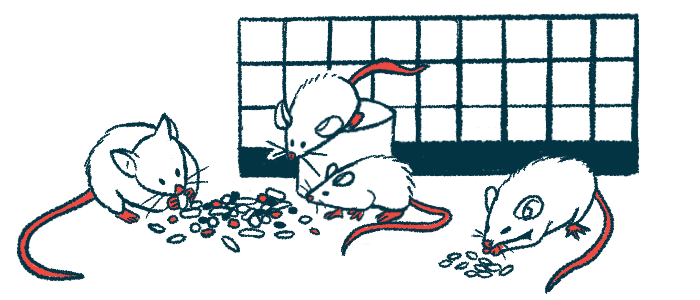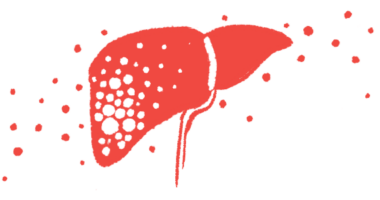Ferroptosis, type of cell death, may be therapeutic target for MASLD
Suppressing it was found to ease liver inflammation, scarring in old mice

A type of cell death called ferroptosis contributes to metabolic dysfunction-associated steatotic liver disease (MASLD), a form of fatty liver disease that occurs more frequently with aging, and as such, could be a potential therapeutic target.
That’s according to a study analyzing old and young healthy mice, mouse models of MASLD — formerly known as nonalcoholic fatty liver disease — and liver tissue from patients.
The findings suggest that suppressing ferroptosis, an iron-dependent form of cell death, might be a therapeutic approach to ease or even reverse liver damage in MASLD. Indeed, treatment with a ferroptosis suppressor reduced the number of senescent liver cells — those that have stopped dividing but haven’t died yet — and eased liver inflammation and scarring in old mice with diet-induced MASLD.
“Together, we’ve shown that aging exacerbates non-alcoholic liver disease by creating ferroptic stress, and by reducing this impact, we can reverse the damage,” Anna Mae Diehl, MD, the study’s senior author and a professor of medicine at the Duke University School of Medicine, in North Carolina, said in a university news story.
“This is hopeful for all of us,” Diehl said. “It’s like we had old mice eating hamburgers and fries, and we made their livers like those of young teenagers eating hamburgers and fries.”
The study, “Aging promotes metabolic dysfunction-associated steatotic liver disease by inducing ferroptotic stress,” was published in Nature Aging.
Seeking to better understand how aging affects the liver
MASLD is characterized by the abnormal accumulation of fat in the liver that’s related to aging-exacerbated metabolic conditions, such as obesity or high levels of fatty molecules in the blood.
Fat accumulation in the liver can cause it to become inflamed and scarred. Over time, this can progress to cirrhosis, or permanent scarring, which in turn can cause the liver to fail.
Its exact driving mechanisms are unclear but older age is known to increase the chances of developing fatty liver disease and progressing to liver failure, where a liver transplant is required.
First, to better understand how aging affects hepatocytes, the liver’s main working cells, Diehl’s team compared genetic data from old versus young mice. The goal was to identify genes that were either more active or less active with aging.
The results showed a genetic signature unique to old hepatocytes that captured the “detrimental effects of chronological aging that promote tissue damage and, thereby, susceptibility to degeneration,” the team wrote.
When the researchers looked at liver samples from obese adults with MASLD and age-matched obese adults without the condition, they found that this signature also became more enriched with age, but only in the MASLD group.
[The findings indicate that] the livers of obese patients with MASLD … are biologically older than those of people without MASLD, who are similarly obese and the same chronological age.
“These results suggest that patients with MASLD and obesity accumulate [hepatocytes] that exhibit hallmarks of aging as they become older, whereas this does not occur in people with similar obesity but without MASLD,” the researchers wrote.
The findings also indicate that “the livers of obese patients with MASLD … are biologically older than those of people without MASLD, who are similarly obese and the same chronological age,” the team added.
In agreement, the genetic signature of aging hepatocytes grew stronger with more severe MASLD based on tissue features, as well as higher levels of blood biomarkers of liver damage.
MASLD was associated with reduced activity of hepatocyte-specific metabolic functions, as well as elevated activity of genes related to insulin resistance, which occurs when the body stops responding to insulin, the hormone controlling blood sugar levels. Other signature genes were associated with a type of cellular damage called oxidative stress, programmed cell death, and the movement of metal ions into and out of or within cells.
“Together, the findings suggest that biologically old [hepatocytes] contribute to metabolic dysfunction, injury and maladaptive repair in livers with MASLD,” the team wrote.
Identifying this therapeutic target will guide further research
Further analyses showed that MALSD patients had significantly higher activity among genes related to ferroptosis than did those with healthy livers. Ferroptosis is an iron-dependent type of programmed cell death that’s been suggested to play a role in MASLD. It occurs when highly reactive fatty molecules build up, leading to oxidative stress and cell damage.
In addition, liver cells of old mice were more vulnerable to ferroptosis-induced damage than were those of young mice.
“We found that aging promotes a type of programmed cell death in hepatocytes called ferroptosis, which is dependent on iron,” Diehl said. “Metabolic stressors amplify this death program, increasing liver damage.”
To test whether MASLD progression may be the result of an increase in ferroptotic stress with age, the researchers treated old and young mice with diet-induced MASLD with ferrostatin-1 (Fer1), a molecule that suppresses ferroptosis.
The MALSD-inducing diet “increased ferroptotic stress more in old mice than in young mice,” the researchers wrote. However, treating old mice with Fer1 reversed the effects of aging so much so that their livers looked biologically like young, healthy livers.
Treatment with Fer1 also reduced inflammation, scarring, and the buildup of fat in the liver.
According to the researchers, this showed that ferroptosis is a potential therapeutic target.
“Inhibiting ferroptosis shifts the liver transcriptome [the set of all gene readouts] of old mice toward that of young mice and reverses aging-exacerbated liver damage, identifying ferroptosis as a tractable, conserved mechanism for aging-related tissue degeneration,” the team concluded.
For Diehl and her team, this work has provided a definitive target for further research.
“Our study demonstrates that aging is at least partially reversible,” Diehl said. “You are never too old to get better.”








